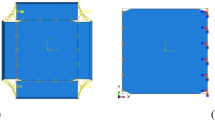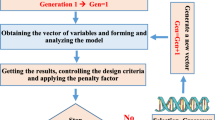Abstract
The traditional design method of the structure is commonly conceived by designers based on demands, thoughts, and experiences. However, this process is often time-consuming and hard to get the optimal solution. Automatic optimal design is the future development trend of structural design. The main purpose of this study is to propose an automatic optimization design method for building structures. The optimization method is based on constraint sensitivity data. Design constraint sensitivities can indicate the optimal changing directions of design variables. Based on the initial design, the sensitivity data can provide the optimal direction of structural material adjustment. Employing sensitivity data can realize the compliance design by the minimum material increment, and realize the optimization design by the maximum material decrement, thus to meet the performance requirements of super high-rise building structures with high efficiency and low cost. The design automation process is also described based on a modeling-analysis-design methodology. A frame shear wall structure is to be employed to show the viability and process of constraint sensitivity data-driven structural design automation.
Access provided by Autonomous University of Puebla. Download conference paper PDF
Similar content being viewed by others
Keywords
- Optimal Design
- Sensitivity analysis
- Frame shear wall structure
- Constraint sensitivity data
- Design Automation
1 Introduction
Structure optimal design is attracting research interest in the building industry, especially in the design of tall buildings. Optimal design method includes objectives, constraints, and design variables. Objective function is minimized (or maximized) during optimization. Design objectives can be weight, structural cost, or seismic energy. Constraint functions are the criteria that the system has to satisfy for each feasible design. Constraints include stress, displacement, drift, etc. Design variables generally are member sizes in structure optimal design.
Constraint sensitivity data is usually used as the driving direction of structure optimal design. According to the sensitivity of the constraint conditions to the size of each component, the size of the component can be modified reasonably to make the final constraint in a reasonable range of redundancy. Based on the principle of virtual work, Jiang Xiang [1] deduced the relationship between the top acceleration and the component size of super tall building under lateral wind vibration. And, based on the sensitive data, the actual super tall building is optimized. Sensitivity analysis based optimization method to optimize structures subject to story drift constraint under earthquake action was studied [2].
Structure optimal design method is generally based on optimization algorithm. XieYimin [3] used the bi-directional evolutionary structural optimization algorithm to carry out architectural design, and through a series of cases, elaborated the use of bi-directional evolutionary optimization algorithm to generate beautiful and efficient forms, and revealed the important role of modern structural topology optimization algorithm in architectural design. Dong Yaoming proposed an optimal design for the structure lateral system of super tall buildings under multiple constraints [4]. Cao Benfeng developed a multilevel constrained optimal structural design method for reinforced concrete tall buildings [5].
In this paper, a multi-level optimization model design method is proposed. The method classifies the design purpose, design variables and constraints into component, component assemble and global levels. With the constraint sensitive data as the driving direction, and combined with the bi-directional evolutionary structural optimization idea, the automatic optimal design of the structure is finally realized. The design automation process is also described based on a modeling-analysis-design methodology (MAD).
2 Digital Modeling
The general structure design can be divided into four stages: planning, design, construction and maintenance. This paper introduces the concept of digital modeling in design stage. Digital modeling can be divided into four stages: geometric modeling, physical modeling, structural analysis and structural design, which can be summarized as modeling-analysis-design methodology (MAD). Figure 1 describes the specific process of MAD digital modeling method. The design elements of each modeling stage are shown in Table 1.
From Fig. 1 and Table 1, Mad method makes modeling standardized, which is conducive to the automation of structural design and optimization. This is the purpose of this paper.
3 Theoretical Basis
This paper introduces a structural automatic optimization method based on sensitive data-driven and bi-directional evolutionary optimization. The sensitive data can provide a reasonable direction for optimization, while the idea of bi-directional evolutionary optimization provides an algorithm to realize automatic optimization.
3.1 Sensitivity Method
As a tool of structure optimization, sensitivity analysis can provide reasonable optimization direction for structures. In this paper, the sensitivity analysis method of virtual work is used to obtain the first derivative of constraint conditions with respect to design variables, i.e. sensitivity data.
The sensitivity coefficient is defined as follows:
When \(\Delta v^{k}\) tends to 0, the formula (1) can be expressed as a formula (2):
where \(s_{i}^{k}\) refers to the sensitivity coefficient of i-th constraint on the k-th design variable; \(g_{i}\) refers to the value of i-th constraint; \(v^{k}\) refers to the value of k-th design variable.
The relationship between constraints and design variables can be expressed by the principle of virtual work. According to the principle of virtual work, the virtual work done by the load under the real working condition under the displacement generated by the virtual working condition is equal to the virtual work of the internal force, which is expressed as follows.
where \(L_{bi}\) refers to the length of the i-th beam and column elements, \(F_{X}\), \(F_{Y}\), \(F_{Z}\), \(M_{X}\), \(M_{Y}\), \(M_{Z}\) refer to the internal forces of the element under external loads; \(f_{X}\), \(f_{Y}\), \(f_{Z}\), \(m_{X}\), \(m_{Y}\), \(m_{Z}\) refer to the internal force of the element under the virtual load; \(A\) refers to the cross section area of beam and column element; \(A_{Y}\) and \(A_{Z}\) refer to the shear area of beam and column elements; \(I_{X}\), \(I_{Y}\) and \(I_{Z}\) refers to the torsion and bending moment of beam and column under inertia force.
It is assumed that the model is a statically determinate structure, that is to say, the internal force distribution of the structure will not be affected by changing the element size. Then the sensitivity coefficient of constraint conditions with respect to component size can be expressed as follows:
The analysis process of shell element is the same as above. We can get a simplified expression of the sensitivity coefficient.
Where C1, C2, C3, C4 are constants related to internal force, material properties, height, length and unit volume cost of materials.
3.2 Automatic Optimal Design
Based on the ascending bi-directional evolutionary optimization method, Design Modeling can be divided into three levels and check part according to the different level of constraints, which are component level, assembly component level and global structure level. The optimization process of each structure level is shown in Fig. 2.
The general process of realizing structure automatic optimal design by computer is shown in Fig. 2.
After calculating the sensitivity coefficient of the component, the optimization strategy is shown in Fig. 3.
Status a+ refers to that the structure is under-constrained and a- refers to the structure is over-constrained. A indicates those components that are sensitive to the controlling constraint and B indicate those components that are insensitive to the controlling constraint. The arrow indicates the adjustment direction of component size, up indicates increasing component size, and downward indicates decreasing component size.
4 Case Study
This paper takes a single story plane steel frame shear wall as an example. The design parameters and initial member section dimensions are shown in Table 2 and Table 3 (Fig. 4).
Taking the minimum cost as the optimization objective, the constraint conditions are the stress ratio and mid span deflection of the beam, the stress ratio and slenderness ratio of the column, the axial compression ratio of the shear wall, and story drift..The initial calculation results and the redundancy of each constraint are shown in Table 4.
It can be seen that the initial redundancy of each constraint is relatively large.For the structure, the amount of material is not economical enough. The constraint conditions at the member level only need to modify the corresponding member size. Sensitivity analysis is needed for the constraint conditions of the global structure level. The sensitivity index (The index of maximum sensitivity coefficient is designated as 100) of story drift with respect to each member is shown in Fig. 5.
It can be seen that in this model, the sensitivity coefficient of the beam is the largest, which indicates that changing the size of the beam has the greatest impact on the story drift. After obtaining the sensitive data, according to the automatic optimization method in Fig. 2, the optimized component size is shown in Table 5.
The redundancy of each constraint after optimization is shown in Table 6.
It can be seen that the optimized material consumption is more economical, and the constraint redundancy is in a more reasonable range. It is verified that the optimization result is at least a local optimal solution.
5 Conclusions
This paper introduces the MAD modeling method, which decomposes the model into several levels, which is beneficial to the computer programming to realize the goal of automatic optimization of structure. The relationship between constraints and design variables (component size) is established by using the principle of virtual work. Applying sensitive data to the direction of structural optimization can improve the search speed of size modification and save the optimization time. The case results show that the results obtained by this method are reasonable and economical, and the method is expected to be applied to larger structures.
References
Zhao, X., Jiang, X.: Sensitivity analysis of wind-induced acceleration on design variables for super tall buildings. In: Proceedings of IABSE Conference on Structural Engineering: Providing Solutions to Global Challenges, pp. 593–599 (2015)
Qin, L., Zhao, X.: Sensitivity analysis based optimal seismic design of tall buildings under story drift constraint. In: Proceedings of IABSE Conference on Bridges and Structures Sustainability: Seeking Intelligent Solutions, pp. 873–880 (2016)
Xie, Y., Zuo, Z., Lv, J.: Architectural Design through Bi-directional Evolutionary Structural Optimization, Time + Architecture,pp. 20–25 (2014)
Dong, Y.: Optimal design for structure lateral system of super tall buildings under multiple constraints, Tongji University (2015)
Cao, B.: Optimal design for reinforced concrete structure of tall building under multiple constraints, Tongji University (2015)
Author information
Authors and Affiliations
Corresponding author
Editor information
Editors and Affiliations
Rights and permissions
Copyright information
© 2021 The Author(s), under exclusive license to Springer Nature Switzerland AG
About this paper
Cite this paper
Yao, J., Zhao, X., Guo, J. (2021). Constraint Sensitivity Data Driven Automatic Optimal Design of Steel Frame Shear-Wall Structure. In: Atluri, S.N., Vušanović, I. (eds) Computational and Experimental Simulations in Engineering. ICCES 2021. Mechanisms and Machine Science, vol 98. Springer, Cham. https://doi.org/10.1007/978-3-030-67090-0_5
Download citation
DOI: https://doi.org/10.1007/978-3-030-67090-0_5
Published:
Publisher Name: Springer, Cham
Print ISBN: 978-3-030-67089-4
Online ISBN: 978-3-030-67090-0
eBook Packages: EngineeringEngineering (R0)









